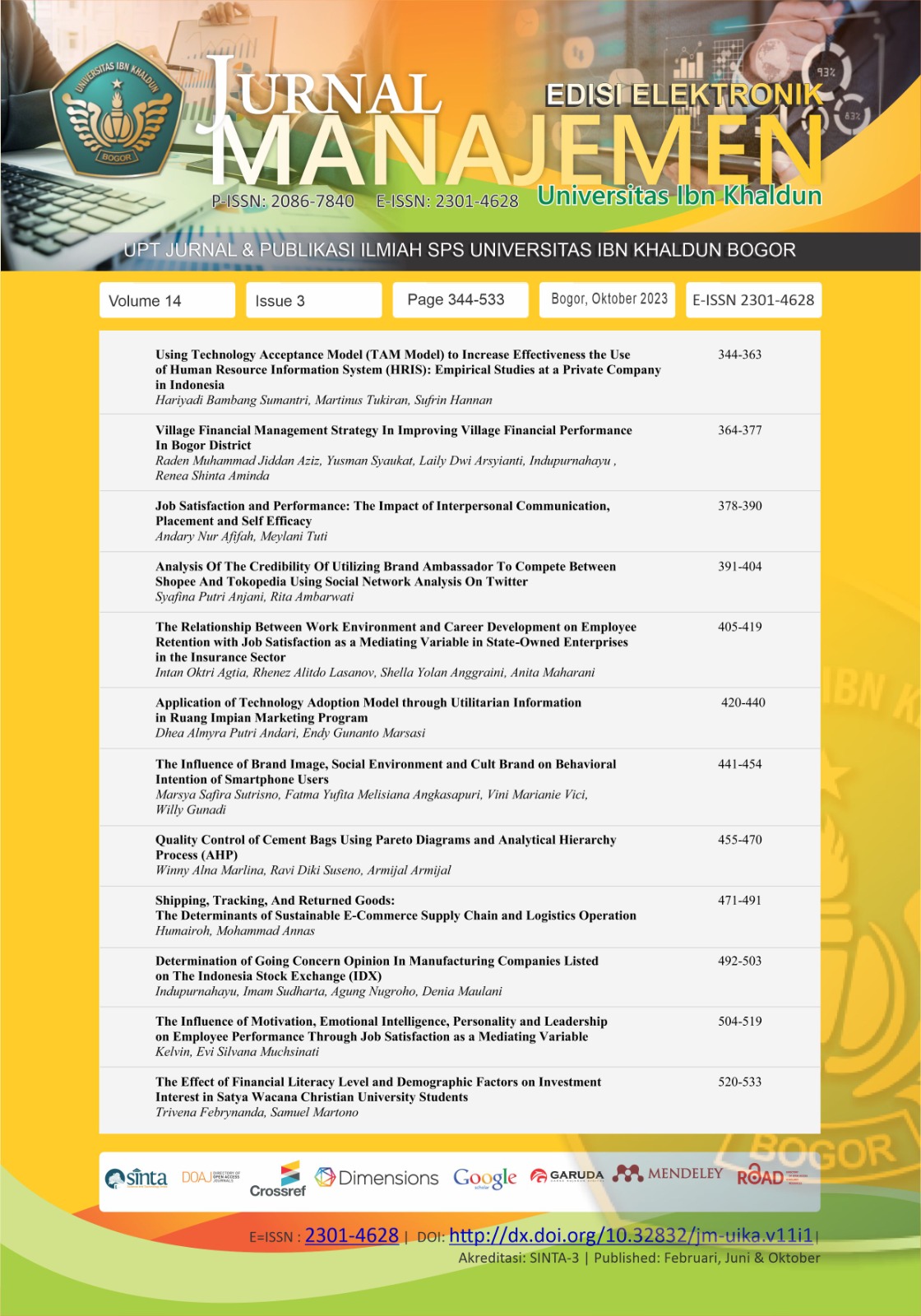Job Satisfaction and Performance: The Impact of Interpersonal Communication, Placement and Self Efficacy
DOI:
https://doi.org/10.32832/jm-uika.v14i3.14274Keywords:
Interpersonal Communication, Job Satisfaction, Performance, Placement, Self EfficacyAbstract
Employee work happiness may be influenced by self-efficacy, interpersonal communication, and job placement, which in turn increases performance. The goal of this study was to examine how work placement, interpersonal communication, and elf effectiveness affected job performance and satisfaction. Employees of the National Police Headquarters SSDM made up the study's sample. Simple random sampling was used to collect samples from the 151 employees from several division who agreed to complete a questionnaire. A structural equation model (SEM) employing smart PLS software is used in the analytical procedure. The study's findings indicate that self-efficacy and interpersonal communication have a substantial impact on job satisfaction and performance. The significance of confidence and interpersonal communication in achieving employee job satisfaction to produce maximum performance.
References
Billett, S. (2020). Enriching Higher Education Students’ Learning through Post-work Placement Interventions (Vol. 28).
Braithwaite, D. O., & Schrodt, P. (2015). Engaging Theories in Interpersonal Communication Multiple Perspectives by Dawn O. Braithwaite Paul Schrodt (z-lib.org) (1). 2.
Devito, J. A. (2016). The Interpersonal Communication Book.
Ghozali, I. (2011). Aplikasi Analisis Multivariate Dengan Program SPSS. Universitas Diponegoro.
Hargie, O., & Dickson, D. (2005). Skilled interpersonal communication. In Taylor & Francis e-Library (Vol. 4, Issue 1).
Hechavarria, D. M., Renko, M., & Matthews, C. H. (2012). The nascent entrepreneurship hub: Goals, entrepreneurial self-efficacy and start-up outcomes. Small Business Economics, 39(3), 685–701. https://doi.org/10.1007/s11187-011-9355-2
Hellwig, A. (2016). Top performance. Textile Month, 1(3), 35–36. https://doi.org/10.7748/ns.19.46.70.s53
Jacobs, K., Hellman, M., Wuest, E., & Markowitz, J. (2013). Job Performance. Encyclopedia of Behavioral Medicine. https://doi.org/10.1007/978-1-4419-1005-9
Kanapathipillai, K., Shaari, A. B., & Mahbob, N. N. (2021). the Influence of Self-Efficacy on Job Performance of Employees in the Online Retail Sector in Malaysia – the Mediating Effect of Innovative Behaviour. European Journal of Human Resource Management Studies, 5(3), 85–111. https://doi.org/10.46827/ejhrms.v5i3.1188
Khoa, B. T. (2023). The role of self-efficacy and firm size in the online advertising services continuous adoption intention: Theory of planned behavior approach. Journal of Open Innovation: Technology, Market, and Complexity, 9(1), 100025. https://doi.org/10.1016/j.joitmc.2023.100025
Kreitner, R., & Kinicki, A. (2010). Organizational Behavior. In McGraw-Hill Education.
Krejcie, R., V.Morgan, & W., D. (1996). (1970) “Determining sample Size for Research Activities”, Educational and Psychological Measurement. International Journal of Employment Studies, 18(1), 89–123.
Maddux. (1995). SELF-EFFICACY, ADAPTATION, AND ADJUSTMENT. SPRINGER SCIENCE+BUSINESS MEDIA.
Mahmood, N. S., Ajmi, A. A., Sarip, S., Kaidi, H. M., Suhot, M. A., Jamaludin, K. R., & Talib, H. H. A. (2022). Modeling energy management sustainability: Smart integrated framework for future trends. Energy Reports, 8, 8027–8045. https://doi.org/10.1016/j.egyr.2022.06.023
McCue, C. P., & Gianakis, G. A. (1997). The Relationship between Job Satisfaction and Performance: The Case of Local Government Finance Officers in Ohio. Public Productivity & Management Review, 21(2), 170. https://doi.org/10.2307/3380882
Motowidlo, S. J., & Kell, H. J. (2012). Chapter 5 Job Performance. Handbook of Psychology, 91–131.
Mtahis, R. L., & Jackson, J. N. (2011). Human Resource Management. In Harvard Business Review (13th ed., Vol. 13, Issue January 2019). Cengage Learning.
Newstrom, J. (2007). Organizational Behavior - Human Behavior at Work (12e). In McGraw-Hill/Irwin.
Ridwan, M. (2015). Analisis prosedur penerimaan, seleksi dan penempatan karyawan pada lpp tvri sumsel babel palembang. Jurnal Ilmiah Orasi Bisnis, 13, 60–69.
Roberts, J. A., & David, M. E. (2020). Boss phubbing, trust, job satisfaction and employee performance. Personality and Individual Differences, 155(November 2019), 109702. https://doi.org/10.1016/j.paid.2019.109702
Schunk, D. H. (2011). Self-Efficacy and Academic Motivation Self-Efficacy and Academic Motivation. Educational Psychologist, 26(February 2014), 37–41. https://libres.uncg.edu/ir/uncg/f/D_Schunk_Self_1991.pdf
Schunk, D. H., & Pajares, F. (2002). The Development of Academic Self-Efficacy. In Development of Achievement Motivation (pp. 15–31). https://doi.org/10.1016/b978-012750053-9/50003-6
Singh, A. K., & Lalropuii. (2014). Role of interpersonal communication in organizational effectiveness. International Journal of Research in Management & Business Studies, 1(4), 36–39.
Sugiyono. (2018). metode penelitian manajemen (M. P. Setiyawami, S.H. (ed.); 6th ed.).
Umar. (2010). Desain Penelitian MSDM dan perilaku karyawan (p. 62). PT RajaGrafindo. https://repository.dinus.ac.id/docs/ajar/RANCANGAN_DESAIN_PENELITIAN_(1).pdf
Virginia Koutroubas, & Michael Galanakis. (2022). Bandura’s Social Learning Theory and Its Importance in the Organizational Psychology Context. Journal of Psychology Research, 12(6). https://doi.org/10.17265/2159-5542/2022.06.001
Downloads
Published
How to Cite
Issue
Section
License
Copyright (c) 2023 Jurnal Manajemen (Edisi Elektronik)

This work is licensed under a Creative Commons Attribution-NonCommercial 4.0 International License.
Authors who publish with this journal agree to the following terms:
- Authors retain copyright and grant the journal right of first publication with the work simultaneously licensed under a Creative Commons Attribution-NonCommercial-ShareAlike 4.0 International License that allows others to share the work with an acknowledgement of the work's authorship and initial publication in this journal.
- Authors can enter into separate, additional contractual arrangements for the non-exclusive distribution of the journal's published version of the work (e.g., post it to an institutional repository or publish it in a book), with an acknowledgement of its initial publication in this journal.
- Authors are permitted and encouraged to post their work online (e.g., in institutional repositories or on their website) prior to and during the submission process, as it can lead to productive exchanges, as well as earlier and greater citation of published work (See The Effect of Open Access).











